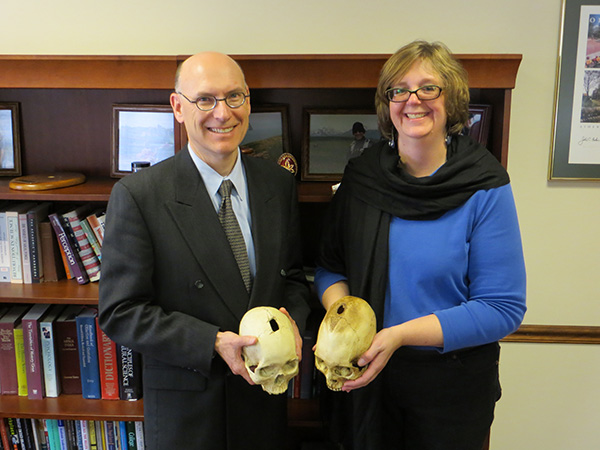
Dean Robert Frank and Dr. Nancy Tatarek share a common interest in bones. On visiting Tatarek’s forensic anthropology lab, Frank discovered that they both have skull casts that were surgically perforated, or trephined, about 400 years ago.
Dean Robert Frank and Dr. Nancy Tatarek share a common interest in bones. On visiting Tatarek’s forensic anthropology lab, Frank discovered that they both have skull casts that were surgically perforated, or trephined, about 400 years ago.
Imagine the following circumstances. You are taking a new drug developed to minimize the effects of the flu, and a few days into your treatment you notice that you cannot smell anything. Is it the flu or is it the drug? Or suppose your mother is having trouble remembering. Is it normal aging or the first signs of Alzheimer’s disease?
In both of these cases, it would be helpful to know how often people lose the sense of smell or have memory problems. What is needed is a set of standards that can be used to determine whether the loss of smell is likely due to a drug side-effect, and whether your mother’s memory loss is just part of normal aging.
Doctors and researchers now have new standardized tools to measure neurologic and behavioral function—including a 5-minute scratch-and-sniff smell test co-authored by College of Arts and Sciences Dean Robert Frank.
The NIH Toolbox for Assessment of Neurological and Behavioral Function—nine years in the making and released in March—provides a set of integrated tools for measuring neurologic and behavioral function. It is designed to be simple to administer in a clinical setting to assess patients. It also provides standardization for research involving epidemiologic studies and clinical trials, making comparison possible across diverse clinical studies.
In total, the NIH Toolbox is designed to be affordable—costing less than $2,000 in equipment—and timely. “The entire battery was created to be administered, at least to healthy subjects, within two hours,” according to a Neurology article. (http://www.neurology.org/content/80/10/874.full.html)
Frank, whose research involves the sense of smell, co-authored one Toolbox section, “Olfactory Assessment Using the NIH Toolbox,” with researchers from across the nation. One of their tasks was to develop a smell test that could be used for people of all ages including very young children. The aim was a brief test that was simple yet accurate across the age spectrum.
“Individuals can vary widely in their ability to detect, recognize, and identify odors but still be within the range of normal function,” the abstract notes. “Although several standardized tests of odor identification are available, few specifically address the issues in testing very young children, most of whom are likely to be unfamiliar with many of the odor stimuli used in adult tests and have limited ability to read and identify labels to select among choices.”
Drawing on previous research, the authors developed “two versions of an odor identification test using standardized odor stimuli in a scratch-and-sniff format.” Participants match the odor to pictures. For children, there are five odors and pictures, for adults nine. These tests are shorter than previous instruments, but as the researchers proved, just as accurate.
“Results from normative testing and validation showed that for most participants, the test could be completed in 5 minutes or less and that the poorer performance among the youngest children and the elderly was consistent with data from tests with larger numbers of items. Expanding on the pediatric version of the test with adult-specific and public health-relevant odors increased the ecological validity of the test and facilitated comparisons of intra-individual performance across developmental stages.”
Other NIH Toolbox tests assess taste, balance and equilibrium, vision, hearing, pain, cognition, motor skills, emotion, and somatosensation (sensory information from muscles, joints, skin and ligaments).



















Comments